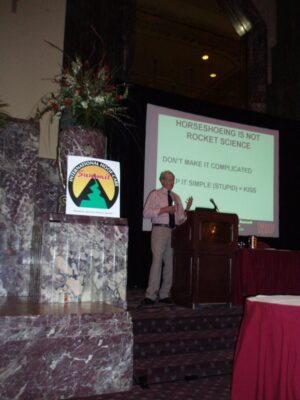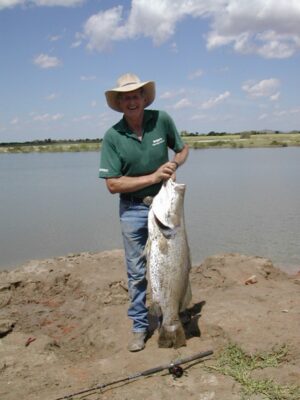I hadn’t been to America until last month (February 2005), and it was a great new experience. I went for horse reasons (well why else would I go) and America certainly has plenty of horses (although I am told that Australia has more on a per capita basis). I had been running courses in Western Australia during February where the temperature in Geraldton was well over 40 degrees Celsius. My last course was at Northam in more moderate temperatures, then I had to sprint across the Nullarbor to get home in time to catch the plane to LA.
I nearly didn’t make it – water in the fuel left my Patrol hiccuping for the next few hundred kilometres, and I limped into Border Village at five kilometres per hour. There was no RAA patrol and no mechanic, but there was an angel on my shoulder in the shape of a fisherman at the local caravan park, who was a home mechanic with a Patrol of his own and he just happened to have a new fuel filter to get me mobile again on my way home, bless him. … Continue Reading ››Category Archives: Teaching & Travelling
teaching & travelling
HOOF CARE SUMMIT IN CINCINNATI

After putting my proverbial toe into the water by checking out farriery in the United States last year, I was invited by the American Farriers Industry Association to address the Third Annual International Hoof Care Summit in Cincinnati in February 2006. Not only that, but I was invited to give both the opening and the closing lectures. I wondered if maybe I had put my whole foot in my mouth instead of in the water – was I being honoured by this invitation or perhaps being lined up for the firing squad?
The two topics I selected were my usual bandwagons – I would open with ‘Back to Basics’ and close with ‘What has happened to the K.I.S.S. Principle’. Everyone who has ever worked with me or attended one of my courses could probably just about recite by heart what I would say.
I did research some … Continue Reading ››
SURVIVAL
The end result of correct hoof care is survival.
Many years ago, in 1954 to be exact, I learnt to shoe a horse while employed as a jackeroo on a remote station. It soon became obvious while out mustering that if the shoes did not stay on, the horse soon became lame and I had to walk home leading him, regardless of the weather conditions and time of the day. This taught me very quickly to put shoes on to stay on.
Now forty-nine years later, I guess it never crossed my mind that those needs would still apply in today’s modern world with our rapid transport and communications, but they certainly do.
On a recent working tour of our far-northern areas, it was a huge reality check to find that now, perhaps more than ever before, it is so important for our working stockhorses to be shod correctly. Today’s horsemen … Continue Reading ››
IF HORSES COULD TALK
JUST LOOK AT THAT HOOF
I have heard that to tell if a person is healthy, just look at the eyes. I don’t know how true that is, but with a horse, I definitely try and encourage people to look at the hoof, and the hoof will show you 95% of what the horse is feeling. If people would look at the hooves when buying a horse, it would save a lot of heartache, and a lot of money.
I was sight-seeing in New York in November, thinking of anything but horses, when I saw a horse skeleton in a Fifth Avenue window display.(Pic 1) Fortunately the horse was dead, as its front feet had been trimmed to the shape of hind feet, so it must have had a pretty miserable life.
I continued along Fifth Avenue, and stopped to chat to two mounted policewomen, both on beautiful quiet horses, (Pic 2) but both horses were far too long in the toe (Pic 2a & 2b) and must have been most uncomfortable standing … Continue Reading ››
TEACHING AUSTRALIAN STYLE
ADIOS
 I retired from teaching at the end of June as I realised that if I keep going I will have been shoeing horses for 60 years next year and that sounded just too ridiculous. I decided to stop writing these articles at the same time as I stop teaching. The reason? I’m turning into a Grey Nomad and going fishing!! Fishing and golf are two things I simply never had enough time for in my life and are now high on my bucket list. One of my first plans is to go helicopter fishing for barramundi with Tony from Katherine. I caught a huge barramundi with Shane Dunn when teaching on … Continue Reading ››
I retired from teaching at the end of June as I realised that if I keep going I will have been shoeing horses for 60 years next year and that sounded just too ridiculous. I decided to stop writing these articles at the same time as I stop teaching. The reason? I’m turning into a Grey Nomad and going fishing!! Fishing and golf are two things I simply never had enough time for in my life and are now high on my bucket list. One of my first plans is to go helicopter fishing for barramundi with Tony from Katherine. I caught a huge barramundi with Shane Dunn when teaching on … Continue Reading ›› TRAIN THE TRAINER
In management courses, the first step is often to train the trainer. I run ABC Hoof Care Courses for horse owners, enabling them to recognise a balanced hoof and, if they wish, to trim or even shoe their own horses. Sometimes I think I should go back a step or two, and teach horse owners some basic horse sense too. Maybe I could call it Train the Owner. At a recent course, all the participants were trimming the hoof in preparation for the shoe. One participant was having trouble with her horse, and repeatedly belted it with a rasp. “If you do that again, I will start crying,” I said. “But she is a bitch,” said the owner in indignation.
I preach total non-violence in shoeing horses, and will not tolerate it from any of my pupils. In these modern times it is no longer acceptable practice to smack a child and it should be equally unacceptable to hit an animal. On seeing new horses, I am often told by my clients that their horse doesn’t … Continue Reading ››